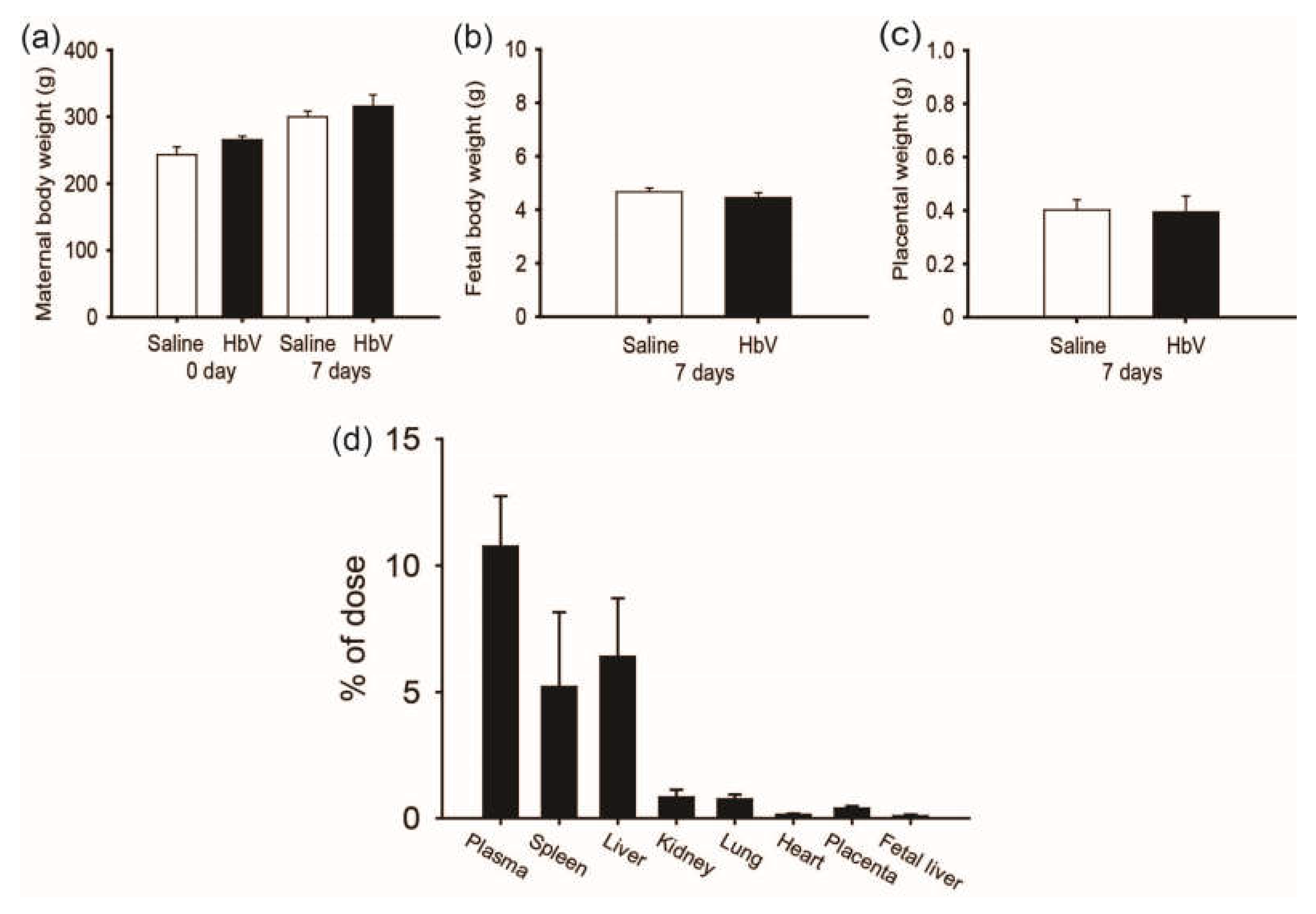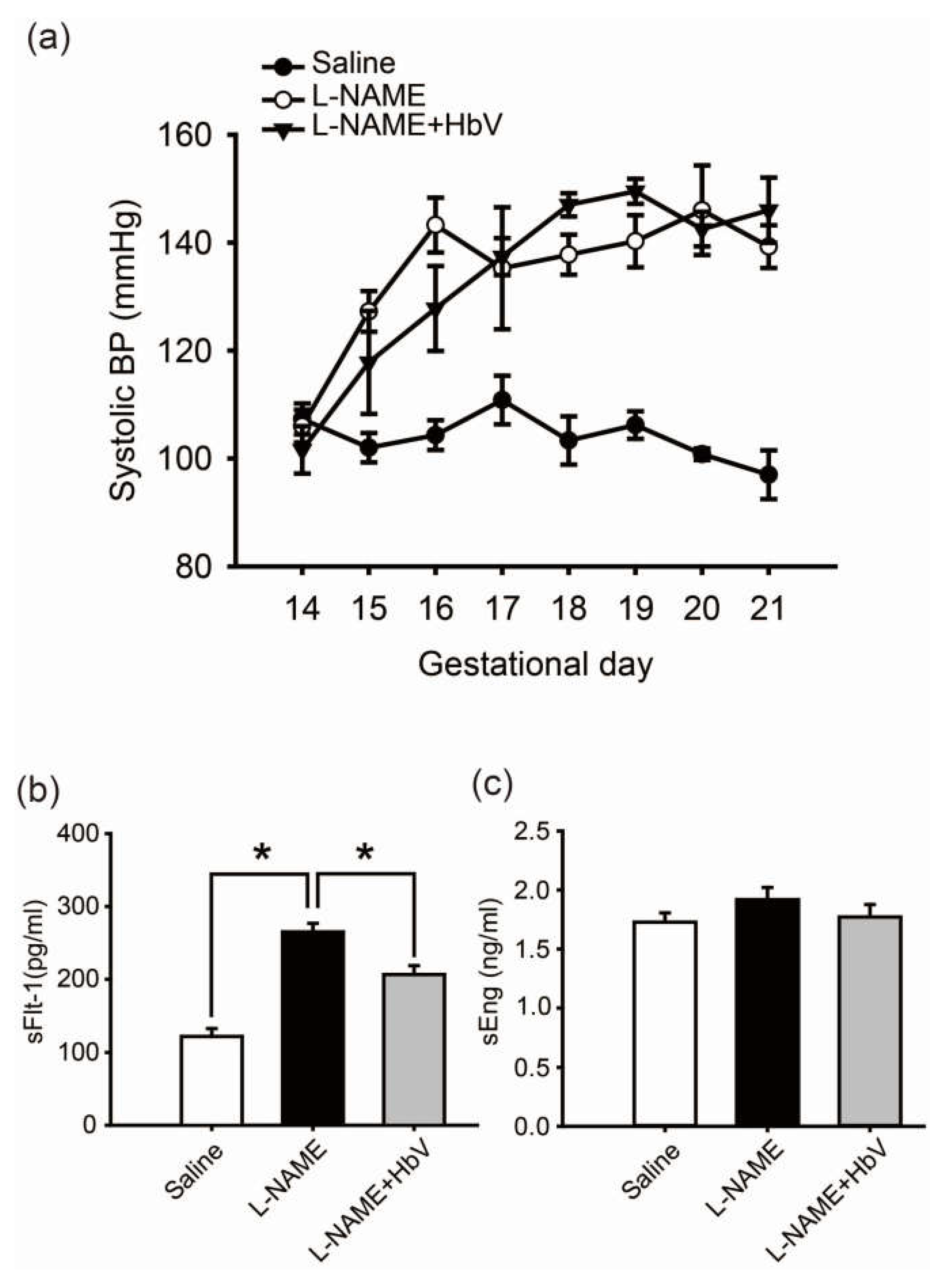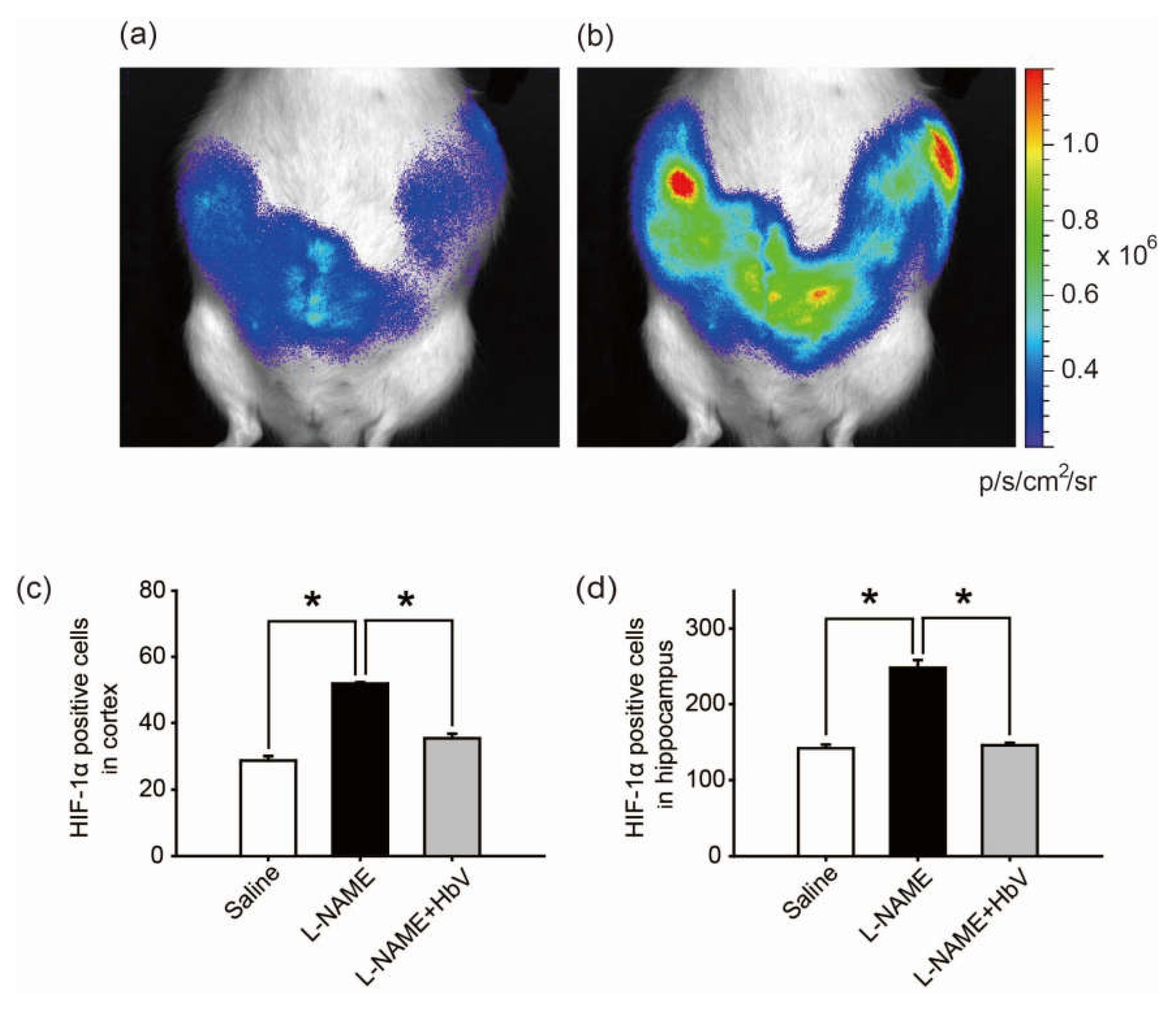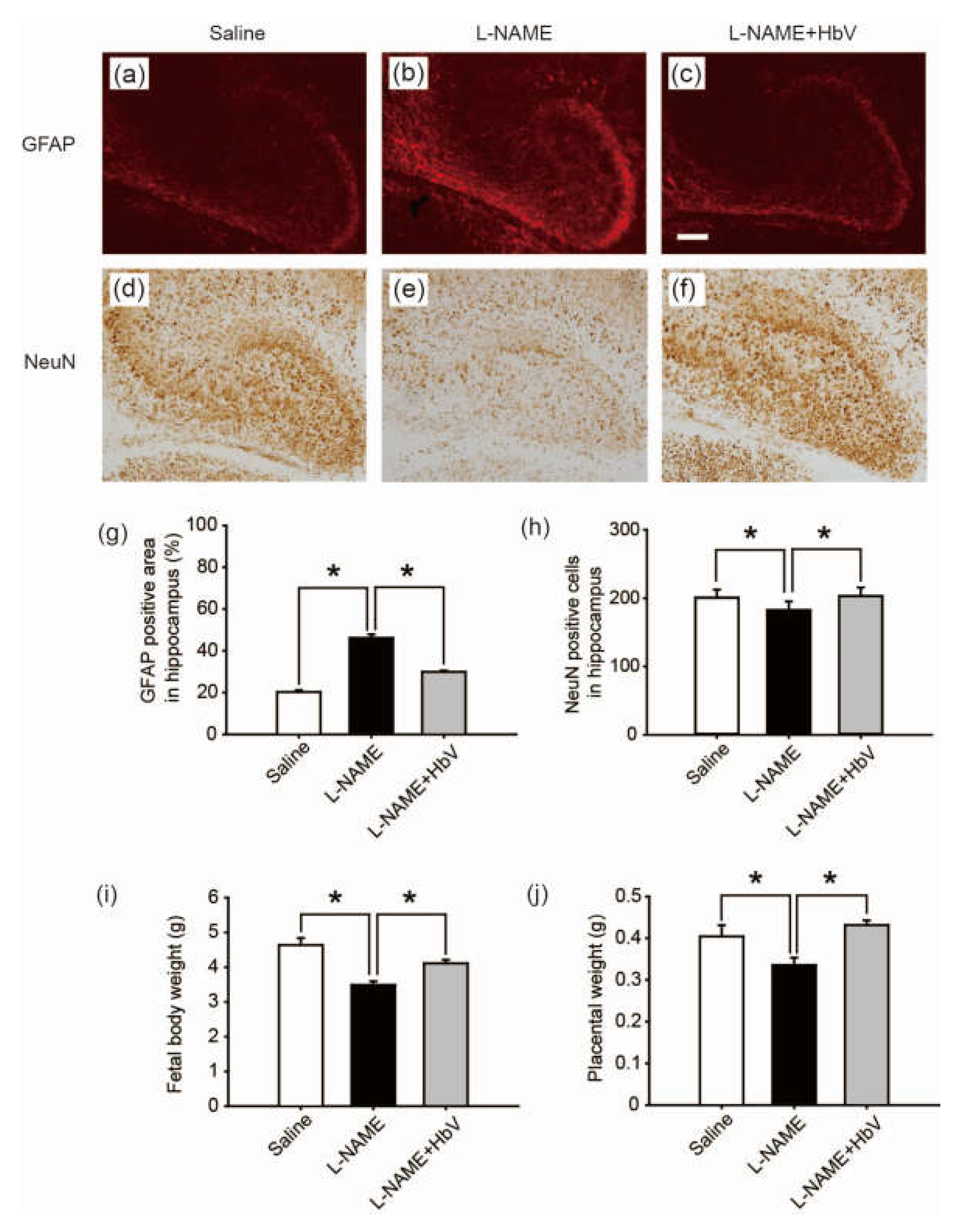Potential New Non-Invasive Therapy Using Artificial Oxygen Carriers for Pre-Eclampsia
Abstract
:1. Introduction
2. Materials and Methods
2.1. Preparation of Hemoglobin Vesicle (HbV) Suspension
2.2. Animals and Experimental Procedures
3. The Safety and Placental Transfer of Hemoglobin Vesicles (HbV) to Rat Fetus in Pregnancy [15]
4. The Rat Pre-Eclampsia Model and Hemoglobin Vesicles (HbV)
4.1. Preparation of the Rat Pre-Eclampsia Model by l-NAME Infusion into Mother Rats
4.2. Change in Maternal Blood Pressure during Gestational Period
4.3. Hemoglobin Vesicles (HbV) Decreased sFlt-1 Plasma Levels in Maternal Blood
4.4. Hemoglobin Vesicles (HbV) Improved Placental Hypoxic Conditions
4.5. Effects of Hemoglobin Vesicle (HbV) Infusion on Fetal Brain and Body Growth under Hypoxic Conditions
4.5.1. Evaluation of Fetal Hypoxic Conditions by Bioluminescence
4.5.2. Evaluation of Hypoxic Conditions of the Fetal Brain
4.5.3. Hemoglobin Vesicles (HbV) Protected Fetal Brain Apoptotic Damage from Hypoxia
4.5.4. Hemoglobin Vesicles (HbV) Improved Fetal Body Growth under Hypoxic Conditions
5. Discussion
6. Conclusions
Acknowledgments
Author Contributions
Conflicts of Interest
References
- Sibai, B.; Dekker, G.; Kupferminc, M. Pre-eclampsia. Lancet 2005, 365, 785–799. [Google Scholar] [PubMed]
- Bibbins-Domingo, K.; Grossman, D.C.; Curry, S.J.; Barry, M.J.; Davidson, K.W.; Doubeni, C.A.; Epling, J.W.; Kemper, A.R.; Krist, A.H.; Kurth, A.E.; et al. Screening for preeclampsia: US Preventive Services Task Force recommendation statement. JAMA. 2017, 317, 1661–1667. [Google Scholar] [PubMed]
- Henderson, J.T.; Thompson, J.H.; Burda, B.U.; Cantor, A. Preeclampsia screening: Evidence report and systematic review for the US Preventive Services Task Force. JAMA. 2017, 317, 1668–1683. [Google Scholar] [CrossRef] [PubMed]
- Myatt, L.; Webster, R.P. Vascular biology of preeclampsia. J. Thromb. Haemost. 2009, 7, 375–384. [Google Scholar] [PubMed]
- Powe, C.E.; Levine, R.J.; Karumanchi, S.A. Preeclampsia, a disease of the maternal endothelium: The role of antiangiogenic factors and implications for later cardiovascular disease. Circulation 2011, 123, 2856–2869. [Google Scholar] [CrossRef] [PubMed]
- Cotechini, T.; Komisarenko, M.; Sperou, A.; Macdonald-Goodfellow, S.; Adams, M.A.; Graham, C.H. Inflammation in rat pregnancy inhibits spiral artery remodeling leading to fetal growth restriction and features of preeclampsia. J. Exp. Med. 2014, 211, 165–179. [Google Scholar] [PubMed]
- Zhou, C.C.; Zhang, Y.; Irani, R.A.; Zhang, H.; Mi, T.; Popek, E.J.; Hicks, M.J.; Ramin, S.M.; Kellems, R.E.; Xia, Y. Angiotensin receptor agonistic autoantibodies induce pre-eclampsia in pregnant mice. Nat. Med. 2008, 14, 855–862. [Google Scholar] [CrossRef] [PubMed]
- Witlin, A.G.; Gangula, P.R.; Wimalawansa, S.J.; Grafe, M.; Grady, J.J.; Yallampalli, C. Adrenomedullin requires an intact nitric oxide system to function as an endogenous vasodilator in rat gestation. Hypertens Pregnancy 2003, 22, 9–24. [Google Scholar] [CrossRef] [PubMed]
- Gilbert, J.S.; Verzwyvelt, J.; Colson, D.; Arany, M.; Karumanchi, S.A.; Granger, J.P. Recombinant vascular endothelial growth factor 121 infusion lowers blood pressure and improves renal function in rats with placental ischemia-induced hypertension. Hypertension 2010, 55, 380–385. [Google Scholar] [CrossRef] [PubMed]
- Herraiz, S.; Pellicer, B.; Serra, V.; Cauli, O.; Cortijo, J.; Felipo, V.; Pellicer, A. Sildenafil citrate improves perinatal outcome in fetuses from pre-eclamptic rats. BJOG 2012, 119, 1394–1402. [Google Scholar] [PubMed]
- Chang, T.M. Therapeutic applications of polymeric artificial cells. Nat. Rev. Drug. Discov. 2005, 4, 221–235. [Google Scholar] [CrossRef] [PubMed]
- Kawaguchi, A.T.; Fukumoto, D.; Haida, M.; Ogata, Y.; Yamano, M.; Tsukada, H. Liposome-encapsulated hemoglobin reduces the size of cerebral infarction in the rat: Evaluation with photochemically induced thrombosis of the middle cerebral artery. Stroke 2007, 38, 1626–1632. [Google Scholar] [CrossRef] [PubMed]
- Tsukimori, K.; Komatsu, H.; Fukushima, K.; Kaku, T.; Nakano, H.; Wake, N. Inhibition of nitric oxide synthetase at mid-gestation in rats is associated with increases in arterial pressure, serum tumor necrosis factor-alpha, and placental apoptosis. Am. J. Hypertens 2008, 21, 477–481. [Google Scholar] [CrossRef] [PubMed]
- Verlohren, S.; Niehoff, M.; Hering, L.; Geusens, N.; Herse, F.; Tintu, A.N.; Plagemann, A.; LeNoble, F.; Pijnenborg, R.; Muller, D.N.; et al. Uterine vascular function in a transgenic preeclampsia rat model. Hypertension 2008, 51, 547–553. [Google Scholar] [CrossRef] [PubMed]
- Kaga, M.; Li, H.; Ohta, H.; Taguchi, K.; Ogaki, S.; Izumi, H.; Inagaki, M.; Tsuchiya, S.; Okamura, K.; Otagiri, M.; et al. Liposome-encapsulated hemoglobin (hemoglobin-vesicle) is not transferred from mother to fetus at the late stage of pregnancy in the rat model. Life Sci. 2012, 91, 420–428. [Google Scholar] [CrossRef] [PubMed]
- Sakai, H.; Hara, H.; Yuasa, M.; Tsai, A.G.; Takeoka, S.; Tsuchida, E.; Intaglietta, M. Molecular dimensions of Hb-based O2 carriers determine constriction of resistance arteries and hypertension. Am. J. Physiol. Heart Circ. Physiol. 2000, 279, 908–915. [Google Scholar]
- Sou, K.; Naito, Y.; Endo, T.; Takeoka, S.; Tsuchida, E. Effective encapsulation of proteins into size-controlled phospholipid vesicles using freeze-thawing and extrusion. Biotechnol. Prog. 2003, 19, 1547–1552. [Google Scholar] [CrossRef] [PubMed]
- Sakai, H.; Tomiyama, K.I.; Sou, K.; Takeoka, S.; Tsuchida, E. Poly(ethylene glycol)-conjugation and deoxygenation enable long-term preservation of hemoglobin-vesicles as oxygen carriers in a liquid state. Bioconjug. Chem. 2000, 11, 425–432. [Google Scholar] [CrossRef] [PubMed]
- Soares, M.J. Molecular mechanisms of placental development. In Placental Function and Fetal Nutrition; Nestec Ltd.: Vevey, Switzerland; Lippincott-Raven Publisher: Philadelphia, PA, USA, 1997; Volume 39, pp. 31–45. [Google Scholar]
- Sakai, H.; Masada, Y.; Horinouchi, H.; Yamamoto, M.; Ikeda, E.; Takeoka, S.; Kobayashi, K.; Tsuchida, E. Hemoglobin-vesicles suspended in recombinant human serum albumin for resuscitation from hemorrhagic shock in anesthetized rats. Crit. Care Med. 2004, 32, 539–545. [Google Scholar] [CrossRef] [PubMed]
- Kakehata, J.; Yamaguchi, T.; Togashi, H.; Sakuma, I.; Otani, H.; Morimoto, Y.; Yoshioka, M. Therapeutic potentials of an artificial oxygen-carrier, liposome-encapsulated hemoglobin, for ischemia/reperfusion-induced cerebral dysfunction in rats. J. Pharmacol. Sci. 2010, 114, 189–197. [Google Scholar] [CrossRef] [PubMed]
- Kubota, Y.; Umegaki, K.; Kagota, S.; Tanaka, N.; Nakamura, K.; Kunitomo, M.; Shinozuka, K. Evaluation of blood pressure measured by tail-cuff methods (without heating) in spontaneously hypertensive rats. Biol. Pharm. Bull. 2006, 29, 1756–1758. [Google Scholar] [CrossRef] [PubMed]
- Hakamata, Y.; Murakami, T.; Kobayashi, E. “Firefly rats” As an organ/cellular source for long-term in vivo bioluminescent imaging. Transplantation 2006, 81, 1179–1184. [Google Scholar] [CrossRef] [PubMed]
- Tahara, Y.; Kuroda, H.; Saito, K.; Nakajima, Y.; Kubo, Y.; Ohnishi, N.; Seo, Y.; Otsuka, M.; Fuse, Y.; Ohura, Y.; et al. In vivo monitoring of peripheral circadian clocks in the mouse. Curr Biol 2012, 22, 1029–1034. [Google Scholar] [CrossRef] [PubMed]
- Deguchi, K.; Oguchi, K.; Takashima, S. Characteristic neuropathology of leukomalacia in extremely low birth weight infants. Pediatr. Neurol. 1997, 16, 296–300. [Google Scholar] [CrossRef]
- Back, S.A. Recent advances in human perinatal white matter injury. Prog. Brain. Res. 2001, 132, 131–147. [Google Scholar] [PubMed]
- Cai, Z.; Pang, Y.; Lin, S.; Rhodes, P.G. Differential roles of tumor necrosis factor-alpha and interleukin-1 beta in lipopolysaccharide-induced brain injury in the neonatal rat. Brain. Res. 2003, 975, 37–47. [Google Scholar] [CrossRef]
- Ramesar, S.V.; Mackraj, I.; Gathiram, P.; Moodley, J. Sildenafil citrate decreases sFlt-1 and sEng in pregnant l-name treated sprague-dawley rats. Eur. J. Obstet. Gynecol. Reprod. Biol. 2011, 157, 136–140. [Google Scholar] [CrossRef] [PubMed]
- Bahtiyar, M.O.; Buhimschi, C.; Ravishankar, V.; Copel, J.; Norwitz, E.; Julien, S.; Guller, S.; Buhimschi, I.A. Contrasting effects of chronic hypoxia and nitric oxide synthase inhibition on circulating angiogenic factors in a rat model of growth restriction. Am. J. Obstet. Gynecol. 2007, 196, 72. [Google Scholar] [CrossRef] [PubMed]
- Freitas, R.A., Jr. Nanomedicine, Vol. IIA: Biocompatibility; Landes Bioscience: Georgetown, TX, USA, 1999; vol.I: 211; Available online: http://www.nanomedicine.com/NMIIA.htm (accessed on 19 August 2015).
- Harry, D.; Patton, A.F.F.; Hille, B. Textbook of Physiology; W.B. Saunders: Philadelphia, PA, USA, 1989; pp. 860–878. [Google Scholar]
- Li, H.; Ohta, H.; Tahara, Y.; Nakamura, S.; Taguchi, K.; Nakagawa, M.; Oishi, Y.; Goto, Y.; Wada, K.; Kaga, M.; et al. Artificial oxygen carriers rescue placental hypoxia and improve fetal development in the rat pre-eclampsia model. Sci. Rep. 2015, 5, 15271. [Google Scholar] [CrossRef] [PubMed]
- Venkatesha, S.; Toporsian, M.; Lam, C.; Hanai, J.; Mammoto, T.; Kim, Y.M.; Bdolah, Y.; Lim, K.H.; Yuan, H.T.; Libermann, T.A.; et al. Soluble endoglin contributes to the pathogenesis of preeclampsia. Nat. Med. 2006, 12, 642–649. [Google Scholar] [CrossRef] [PubMed]
- Holwerda, K.M.; Faas, M.M.; Van Goor, H.; Lely, A.T. Gasotransmitters: A solution for the therapeutic dilemma in preeclampsia? Hypertension 2013, 62, 653–659. [Google Scholar] [CrossRef] [PubMed]
- Jerkic, M.; Letarte, M. Contribution of oxidative stress to endothelial dysfunction in hereditary hemorrhagic telangiectasia. Front Genet 2015, 6, 34. [Google Scholar] [CrossRef] [PubMed]





© 2017 by the authors. Licensee MDPI, Basel, Switzerland. This article is an open access article distributed under the terms and conditions of the Creative Commons Attribution (CC BY) license (http://creativecommons.org/licenses/by/4.0/).
Share and Cite
Ohta, H.; Kaga, M.; Li, H.; Sakai, H.; Okamura, K.; Yaegashi, N. Potential New Non-Invasive Therapy Using Artificial Oxygen Carriers for Pre-Eclampsia. J. Funct. Biomater. 2017, 8, 32. https://doi.org/10.3390/jfb8030032
Ohta H, Kaga M, Li H, Sakai H, Okamura K, Yaegashi N. Potential New Non-Invasive Therapy Using Artificial Oxygen Carriers for Pre-Eclampsia. Journal of Functional Biomaterials. 2017; 8(3):32. https://doi.org/10.3390/jfb8030032
Chicago/Turabian StyleOhta, Hidenobu, Maiko Kaga, Heng Li, Hiromi Sakai, Kunihiro Okamura, and Nobuo Yaegashi. 2017. "Potential New Non-Invasive Therapy Using Artificial Oxygen Carriers for Pre-Eclampsia" Journal of Functional Biomaterials 8, no. 3: 32. https://doi.org/10.3390/jfb8030032
APA StyleOhta, H., Kaga, M., Li, H., Sakai, H., Okamura, K., & Yaegashi, N. (2017). Potential New Non-Invasive Therapy Using Artificial Oxygen Carriers for Pre-Eclampsia. Journal of Functional Biomaterials, 8(3), 32. https://doi.org/10.3390/jfb8030032




